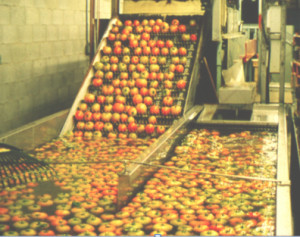Last week, Western Growers released food safety guidelines for the production, harvest and processing of fresh culinary herbs.
According to The Packer, in April 2011, the Food and Drug Administration urged the industry to take action to improve the safety of fresh cilantro. In response, Western Growers  started an initiative to develop commodity-specific guidelines for all fresh herbs as opposed to cilantro only.
started an initiative to develop commodity-specific guidelines for all fresh herbs as opposed to cilantro only.
Good.
But in the wake of the U.S. Centers for Disease Control study fingering produce as the biggest source of foodborne illness amongst known outbreaks, several groups decided this was an ideal moment to lecture consumers rather than explain the food safety challenges of fresh.
And none of them mentioned cantaloupe.
Bad.
ConAgra Foods, purveyors of peanut butter and pot pies that have poisoned hundreds of Americans, teamed with the Academy of Nutrition and Dietetics to tell Americans, rather than avoid certain foods, practice safe food handling at home instead.
My Food Safety Network apparently lives on at the University of Guelph, dispensing advice I never would have provided, because there is little evidence consumers can do much when it comes to fresh produce.
And then there’s the blandness of FightBac, which used the study to remind people, “Any day is a good day to share a reminder about the importance of checking food safety steps at home!”
I’m not even sure that’s a sentence.
Much better and more realistic is the effort by Matt McClure of the Calgary Herald, who wrote the faraway fields of California were the source last year of lettuce tainted with a potentially-fatal bacteria that sickened scores of Canadians in at least three outbreaks.
Media attention has focused on a recent surge of 30 illnesses in the eastern half of the country linked to E. coli-tainted iceberg lettuce distributed to fast-food restaurants, and another outbreak last spring
 involving 23 patients in New Brunswick and Quebec who ate bagged romaine lettuce that was laden with the bacteria.
involving 23 patients in New Brunswick and Quebec who ate bagged romaine lettuce that was laden with the bacteria.
But federal documents — not made public until now — also show a Calgary senior was one of at least three patients who fell sick in a separate outbreak last summer that was also linked to tainted lettuce.
The 84-year-old woman — whom the Herald has agreed not to identify — died last month after being in and out of hospital for months following a severe infection from a strain of E.coli O157: H7 that was a genetic match to the bacteria found in a package of Tanimura and Antle brand lettuce.
“You assume the companies providing a product have all the controls in place to make sure it’s safe,” the woman’s daughter said.
“For our family, that assumption proved deadly.”
The leafy greens marketing types remain under the Sponge Bob cone of silence.
Mansour Samadpour, a microbiologist and lab executive based in Washington, said illness statistics show that programs like California’s Leafy Green Marketing Agreement are failing to make salads safer.
More than 1,200 people around North America have fallen sick after eating the product in the half decade since the program was introduced, twice the number who became ill in the previous five-year period.
“The size and number of lettuce outbreaks in Canada during the last year suggest a serious situation, one that’s arguably worse than the recall of tainted beef from XL Foods,” Samadpour said.
“The leafy green marketing agreements set a bar, but it’s still too low.”
While some retailers like Costco require testing of their suppliers, Samadpour said some in the produce industry balk at the additional cost of about four cents a bag.
“The industry says we triple wash with chlorine but we know that’s not effective in killing bacteria if they are present in large numbers,” Michael Doyle said.
“I think we need to require a reliable regimen of testing of these bagged products, but the problem is it costs money.”
He said one large manufacturer had confessed to him recently it was cheaper to recall product found to be tainted than to have advanced food safety interventions at their processing plants.
Tanimura and Antle did not respond to a request for an interview about its food safety program and how its tainted shipment of lettuce to Canada last summer was only detected when a CFIA official took a random swab at an import facility in Winnipeg.
Leafy greens cone of slience.
A table of leafy green outbreaks is available at http://bites.ksu.edu/leafy-greens-related-outbreaks.
The abstract of the CDC report is below:
Each year, >9 million foodborne illnesses are estimated to be caused by major pathogens acquired in the United States. Preventing these illnesses is challenging because resources are limited and linking individual illnesses to a particular food is rarely possible except during an outbreak. We developed a method of attributing illnesses to food commodities that uses data from outbreaks associated with both simple and complex foods. Using data from outbreak-associated illnesses for 1998–2008, we estimated annual US foodborne illnesses, hospitalizations, and deaths attributable to each of 17 food commodities. We attributed 46% of illnesses to produce and found that more deaths were attributed to poultry than to any other commodity. To the extent that these estimates reflect the commodities causing all foodborne illness, they indicate that efforts are particularly needed to prevent contamination of produce and poultry. Methods to incorporate data from other sources are needed to improve attribution estimates for some commodities and agents.
http://wwwnc.cdc.gov/eid/article/19/3/11-1866_article.htm










.jpeg) Or the sick people.
Or the sick people..jpg) therefore becomes their badge of honor.”
therefore becomes their badge of honor.”.jpg) examined 55 people, including 18 individuals who were sick and 37 people who were not sick.
examined 55 people, including 18 individuals who were sick and 37 people who were not sick.(1)(1)(1).jpg)
 been made public
been made public same type of activity will be repeated with a different theme. A food safety spokesperson will also be pitched to Canadian television and radio outlets in an additional effort to communicate with consumers about the safety of California leafy greens.
same type of activity will be repeated with a different theme. A food safety spokesperson will also be pitched to Canadian television and radio outlets in an additional effort to communicate with consumers about the safety of California leafy greens.  Listeria-stricken Maple Leaf Foods hasn’t posted anything new on its Journey-inspired
Listeria-stricken Maple Leaf Foods hasn’t posted anything new on its Journey-inspired